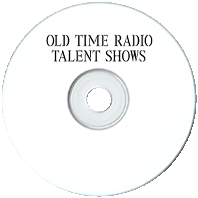

Do you have what it takes to be a Star? If you do well enough on an Amateur Talent Show, and you might get your big break!

28 old time radio show recordings
(total playtime 15 hours, 44 min)
available in the following formats:
1 MP3 CD
or
18 Audio CDs
Text on OTRCAT.com ©2001-2025 OTRCAT INC All Rights Reserved. Reproduction is prohibited.

The contest part of the amateur night came after all the amateurs had performed; the Master of Ceremonies would ask the audience to select a winner. The "winner" may not have been the most talented, often an audience would select who they liked the best, and sympathy could mean as much as talent. Although they claimed amateur status, these acts were often paid, not as much as "professionals" of course, but enough to make it worth the time and talent show experience could be a valuable stepping stone toward "the big time". Many of the most successful acts of the early commercial radio period came from vaudeville, and amateur shows made the transition as well.
After the 1906 earthquake devastated business opportunities (along with his real estate fortune) in his native San Francisco, Ed Bowes moved east to New York where he was delighted to discover the huge opportunities in show business. After successfully producing a few shows, he became the managing director of the Capitol Theatre which opened at 1645 Broadway in 1919. Whether Bowes served in the Great War in either an active or reserve capacity is still debated, but he did insist on being referred to as "Major Bowes" and he ran the Capitol with military efficiency.
The Capitol Theatre was designed as a lavish movie palace but also staged a number of musical revues. These revues provided content for the Capitol Theatre Family Show beginning in 1922 and eventually carried by the Blue or the Red networks. Bowes began broadcasting amateur programs over various stations before landing on WHN in 1934 with The Original Amateur Hour. The next year, sponsorship was picked up by Chase and Sanborn Coffee until Bowes took the show to CBS.
The Original Amateur Hour developed into a talent finding machine, but the mission was always to entertain the listeners at home. Bowes formed several of the best acts from the show into vaudeville touring companies, which also served as scouting missions to find more talented acts. On the air, a "wheel of fortune" was used to determine the order in which the acts would appear, since the audience could not see the wheel on the radio, the spin included musical sound effects and Bowes chanting the popular new catchphrase, "Round and round she goes, where she stops, nobody knows!"
Another talent show innovation Bowes used was the gong. Since these were, in fact, amateurs, there was always a chance that a particular number could turn out to be a real stinker. If things got intolerably terrible, Bowes would smash a Chinese gong as a signal to get them off the stage. Audience reaction to the gong was mixed, and eventually, the gong disappeared from The Original Amateur Hour, but the gimmick lives on in various forms in modern Television talent shows.
Ted Mack came on in 1935 as, "first assistant in the talent selection, production, and direction". In other words, Mack found and recruited the talent and put the show together, freeing Major Bowes to concentrate on hosting duties. Edward Bowes retired just before he passed away in 1946, and Mack stepped into the hosting role and Albert Fisher became the new First Assistant. The Original Amateur Hour is credited with launching the careers Gladys Knight, Anne Margaret, Louis Farrakhan, Alan King, Maria Callas, and the front man for the Hoboken Four vocal group, a kid named Frank Sinatra.
The amateur show/talent search format was simply too appealing not to be copied, and it lives on with wildly popular TV programs today. Other examples from the Golden Age of Radio include:
Text on OTRCAT.com ©2001-2025 OTRCAT INC All Rights Reserved. Reproduction is prohibited.
You have reached the maximum number of votes for a unregistered user.
Please login or create a new account to continue...
You have reached the maximum number to down votes in this page.



Talent Shows Disc A001
|
Add Audio CD to Cart - $5.00 |
Talent Shows Disc A002
|
Add Audio CD to Cart - $5.00 |
Talent Shows Disc A003
|
Add Audio CD to Cart - $5.00 |
Talent Shows Disc A004
|
Add Audio CD to Cart - $5.00 |
Talent Shows Disc A005
|
Add Audio CD to Cart - $5.00 |
Talent Shows Disc A006
|
Add Audio CD to Cart - $5.00 |
Talent Shows Disc A007
|
Add Audio CD to Cart - $5.00 |
Talent Shows Disc A008
|
Add Audio CD to Cart - $5.00 |
Talent Shows Disc A009
|
Add Audio CD to Cart - $5.00 |
Talent Shows Disc A010
|
Add Audio CD to Cart - $5.00 |
Talent Shows Disc A011
|
Add Audio CD to Cart - $5.00 |
Talent Shows Disc A012
|
Add Audio CD to Cart - $5.00 |
Talent Shows Disc A013
|
Add Audio CD to Cart - $5.00 |
Talent Shows Disc A014
|
Add Audio CD to Cart - $5.00 |
Talent Shows Disc A015
|
Add Audio CD to Cart - $5.00 |
Talent Shows Disc A016
|
Add Audio CD to Cart - $5.00 |
Talent Shows Disc A017
|
Add Audio CD to Cart - $5.00 |
Talent Shows Disc A018
|
Add Audio CD to Cart - $5.00 |
Please wait...
COMMENTS
Be the first to comment on "Talent Shows"
Leave a comment